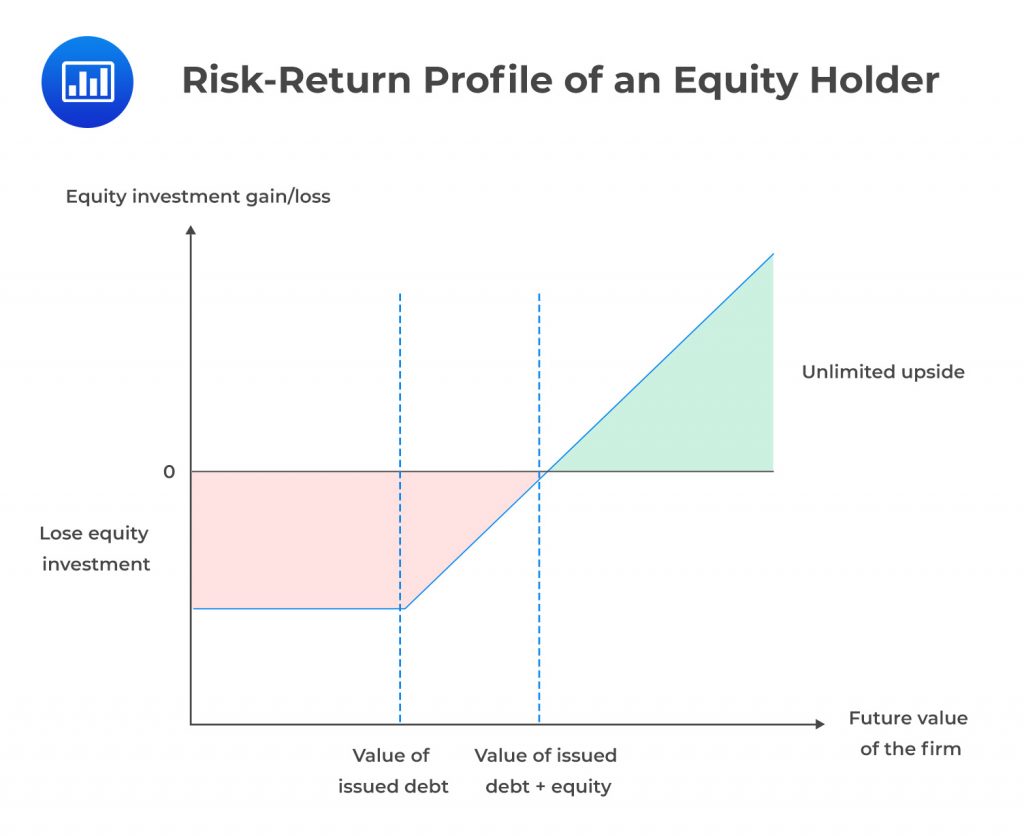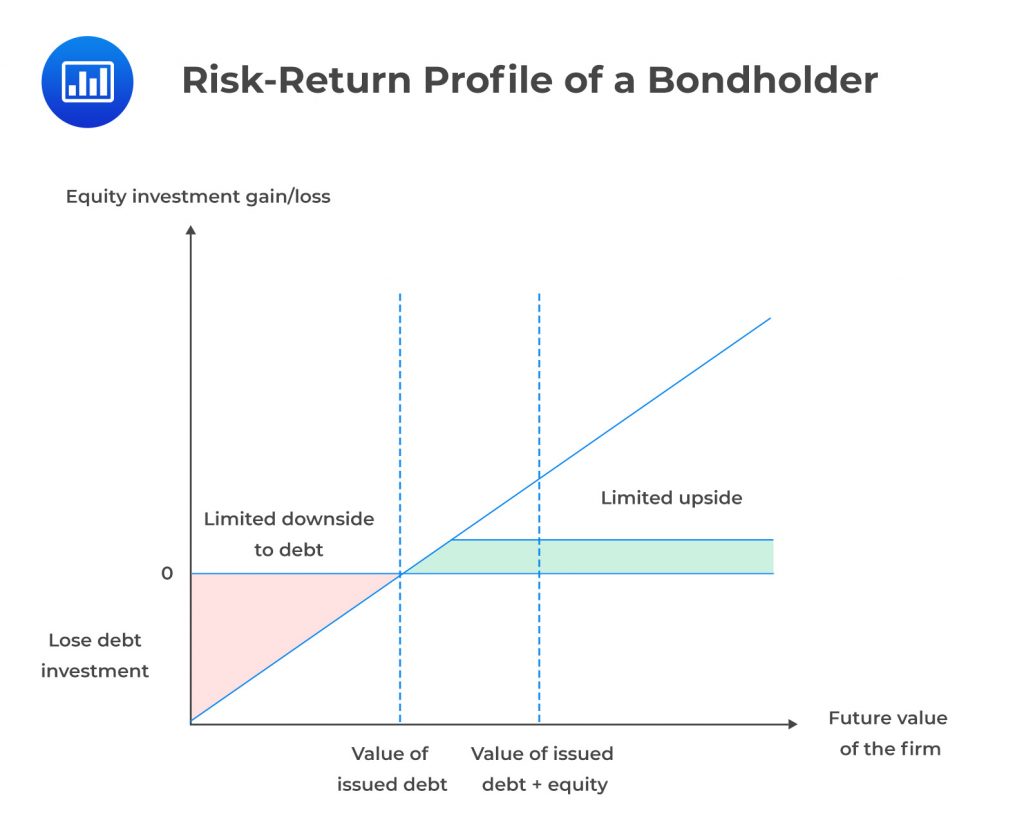DOL, DFL, and DTL
[vsw id=”UO4w5yNuWdw” source=”youtube” width=”611″ height=”344″ autoplay=”no”] The Degree of Operating Leverage, Degree of... Read More
[vsw id=”5nqIpy9pgGM” source=”youtube” width=”611″ height=”344″ autoplay=”no”]
Lenders (debt financiers) and owners (equity financiers) have different binding contracts with a company. The debtholders must be fully paid before distributions are made to the owners (equity holders). Put another way, equity holders are residual claimants to the company. All other stakeholders, such as employees and suppliers, must be paid before equity holders.
The maximum loss equity holders can incur is capped at their investment amount in a company. On the brighter side, equity holders gain an upside if the share prices increase in the future. In other words, there is no limit on the gains to an equity holder if a company succeeds.
Gains come not only in distributions from a company but also in the residual claim after a profitable corporation settles its obligations. This is equivalent to investment interest to investors.
Regarding risks, investment risk is higher for equity holders than bondholders. Stocks are riskier for investors since no contractual obligation is set to distribute risk to the shareholders or repay the capital investment. This implies that equity holders may lose entire investments if a company goes bankrupt.

In conclusion, equity holders are interested in the continuous maximization of a company’s net value. This interest is inspired by the fact that continuous net value maximization translates directly to shareholder share values.
Bondholders have fixed priority claims on a company through contractually promised interest payments and return of the principal amount. Unlike equity holders, bondholders do not receive more than the promised interest payments when a company becomes attractively profitable. However, there is a brighter side to this.
Investment risk is lower for bondholders than equity holders. When a company is financially healthy, bondholders are assured of their returns. This is the case considering such a company’s capacity to easily service a loan. It is equally worth appreciating that a financially healthy company has sufficient assets that serve as collateral. Therefore, the upside gains to a bondholder are capped at the interest payments plus the principal. However, there are downside losses if a company falls below the book value of the debt.

In contrast to equity holders, bondholders have recourse opportunities when a company is in financial distress. Bondholder payments are prioritized in case of financial stress. Moreover, they can use the contractual agreement to force the issuer to liquidate assets to repay their debt. It is important to note that bondholders could lose their entire investment too.
Therefore, bondholders are keener on the default risk of a company and its ability to meet debt obligations. The debt soundness of a company is determined by:
Corporations prefer debt capital to equity capital. This is because the cost of debt is lower than that of equity capital, and the return to the lenders is capped. Moreover, equity capital dilutes ownership and is only appropriate when the issuer’s cash flows are absent or unpredictable.
However, bonds are riskier than shares since they involve contractual agreements which must be honored. Bondholders elevate the risk to the corporation by increasing leverage. The opposite is true for investors. In contrast, investment risk from equity holders is lower because they cannot force the liquidation of assets in case of financial distress.
In extreme cases where an issuer is not able to meet bondholders’ obligations, it can avoid bankruptcy by renegotiating repayment terms with the bondholders. If the negotiation fails, the issuer can file for bankruptcy protection. In this case, assets will be liquidated to pay the bondholders. An extreme solution is the reorganization of the company, where the bondholders take it over.
The interests of the bondholders and equity holders can collide. Since shareholders’ loss is capped at their respective initial investment amount and return potential is unlimited, they prefer a company’s management to invest in areas with high calculated risks and potential returns.
On the other hand, the potential return for bondholders is limited to the face value of a bond and coupon payments. In addition, they do not receive any benefits from the risky investment decisions of the company. Therefore, bondholders prefer a company to invest in less risky projects with certain cash flows, however small, to secure timely interest and principal repayments. Bondholders do not have control over a company’s investment decisions, but they can use covenants to protect their investment.
Question
Which of the following statements is most likely true?
- Bondholders have residual claims on a company’s assets after all other stakeholders have been paid.
- Stocks are riskier than bonds to the issuer since shareholders are the residual claimants on the firm.
- Equity and bondholders have comparable investor perspective regarding to maximum loss.
Solution
The correct answer is C.
The maximum loss for both the bondholders and equity holders is their initial investment amount. However, equity holders have unlimited return potential but are exposed to higher investment risk due to a lack of contractual obligation between them and the issuing company.
A is incorrect. Equity holders are the residual claimants of a company’s cash flows and assets. This implies that they are only paid after all other stakeholders such as creditors, suppliers, and government have been paid.
B is incorrect. Stocks are riskier for investors because the issuing company has no contractual obligation to distribute dividends to shareholders or repay their capital investment. On the other hand, bonds are riskier than stock for the issuer because bonds increase the leverage risk to a company.
[vsw id=”5nqIpy9pgGM” source=”youtube” width=”611″ height=”344″ autoplay=”no”]
Lenders (debt financiers) and owners (equity financiers) have different binding contracts with a company. The debtholders must be fully paid before distributions are made to the owners (equity holders). Put another way, equity holders are residual claimants to the company. All other stakeholders, such as employees and suppliers, must be paid before equity holders.
The maximum loss equity holders can incur is capped at their investment amount in a company. On the brighter side, equity holders gain an upside if the share prices increase in the future. In other words, there is no limit on the gains to an equity holder if a company succeeds.
Gains come not only in distributions from a company but also in the residual claim after a profitable corporation settles its obligations. This is equivalent to investment interest to investors.
Regarding risks, investment risk is higher for equity holders than bondholders. Stocks are riskier for investors since no contractual obligation is set to distribute risk to the shareholders or repay the capital investment. This implies that equity holders may lose entire investments if a company goes bankrupt.

In conclusion, equity holders are interested in the continuous maximization of a company’s net value. This interest is inspired by the fact that continuous net value maximization translates directly to shareholder share values.
Bondholders have fixed priority claims on a company through contractually promised interest payments and return of the principal amount. Unlike equity holders, bondholders do not receive more than the promised interest payments when a company becomes attractively profitable. However, there is a brighter side to this.
Investment risk is lower for bondholders than equity holders. When a company is financially healthy, bondholders are assured of their returns. This is the case considering such a company’s capacity to easily service a loan. It is equally worth appreciating that a financially healthy company has sufficient assets that serve as collateral. Therefore, the upside gains to a bondholder are capped at the interest payments plus the principal. However, there are downside losses if a company falls below the book value of the debt.

In contrast to equity holders, bondholders have recourse opportunities when a company is in financial distress. Bondholder payments are prioritized in case of financial stress. Moreover, they can use the contractual agreement to force the issuer to liquidate assets to repay their debt. It is important to note that bondholders could lose their entire investment too.
Therefore, bondholders are keener on the default risk of a company and its ability to meet debt obligations. The debt soundness of a company is determined by:
Corporations prefer debt capital to equity capital. This is because the cost of debt is lower than that of equity capital, and the return to the lenders is capped. Moreover, equity capital dilutes ownership and is only appropriate when the issuer’s cash flows are absent or unpredictable.
However, bonds are riskier than shares since they involve contractual agreements which must be honored. Bondholders elevate the risk to the corporation by increasing leverage. The opposite is true for investors. In contrast, investment risk from equity holders is lower because they cannot force the liquidation of assets in case of financial distress.
In extreme cases where an issuer is not able to meet bondholders’ obligations, it can avoid bankruptcy by renegotiating repayment terms with the bondholders. If the negotiation fails, the issuer can file for bankruptcy protection. In this case, assets will be liquidated to pay the bondholders. An extreme solution is the reorganization of the company, where the bondholders take it over.
The interests of the bondholders and equity holders can collide. Since shareholders’ loss is capped at their respective initial investment amount and return potential is unlimited, they prefer a company’s management to invest in areas with high calculated risks and potential returns.
On the other hand, the potential return for bondholders is limited to the face value of a bond and coupon payments. In addition, they do not receive any benefits from the risky investment decisions of the company. Therefore, bondholders prefer a company to invest in less risky projects with certain cash flows, however small, to secure timely interest and principal repayments. Bondholders do not have control over a company’s investment decisions, but they can use covenants to protect their investment.
Question
Which of the following statements is most likely true?
- Bondholders have residual claims on a company’s assets after all other stakeholders have been paid.
- Stocks are riskier than bonds to the issuer since shareholders are the residual claimants on the firm.
- Equity and bondholders have comparable investor perspective regarding to maximum loss.
Solution
The correct answer is C.
The maximum loss for both the bondholders and equity holders is their initial investment amount. However, equity holders have unlimited return potential but are exposed to higher investment risk due to a lack of contractual obligation between them and the issuing company.
A is incorrect. Equity holders are the residual claimants of a company’s cash flows and assets. This implies that they are only paid after all other stakeholders such as creditors, suppliers, and government have been paid.
B is incorrect. Stocks are riskier for investors because the issuing company has no contractual obligation to distribute dividends to shareholders or repay their capital investment. On the other hand, bonds are riskier than stock for the issuer because bonds increase the leverage risk to a company.
Get Ahead on Your Study Prep This Cyber Monday! Save 35% on all CFA® and FRM® Unlimited Packages. Use code CYBERMONDAY at checkout. Offer ends Dec 1st.